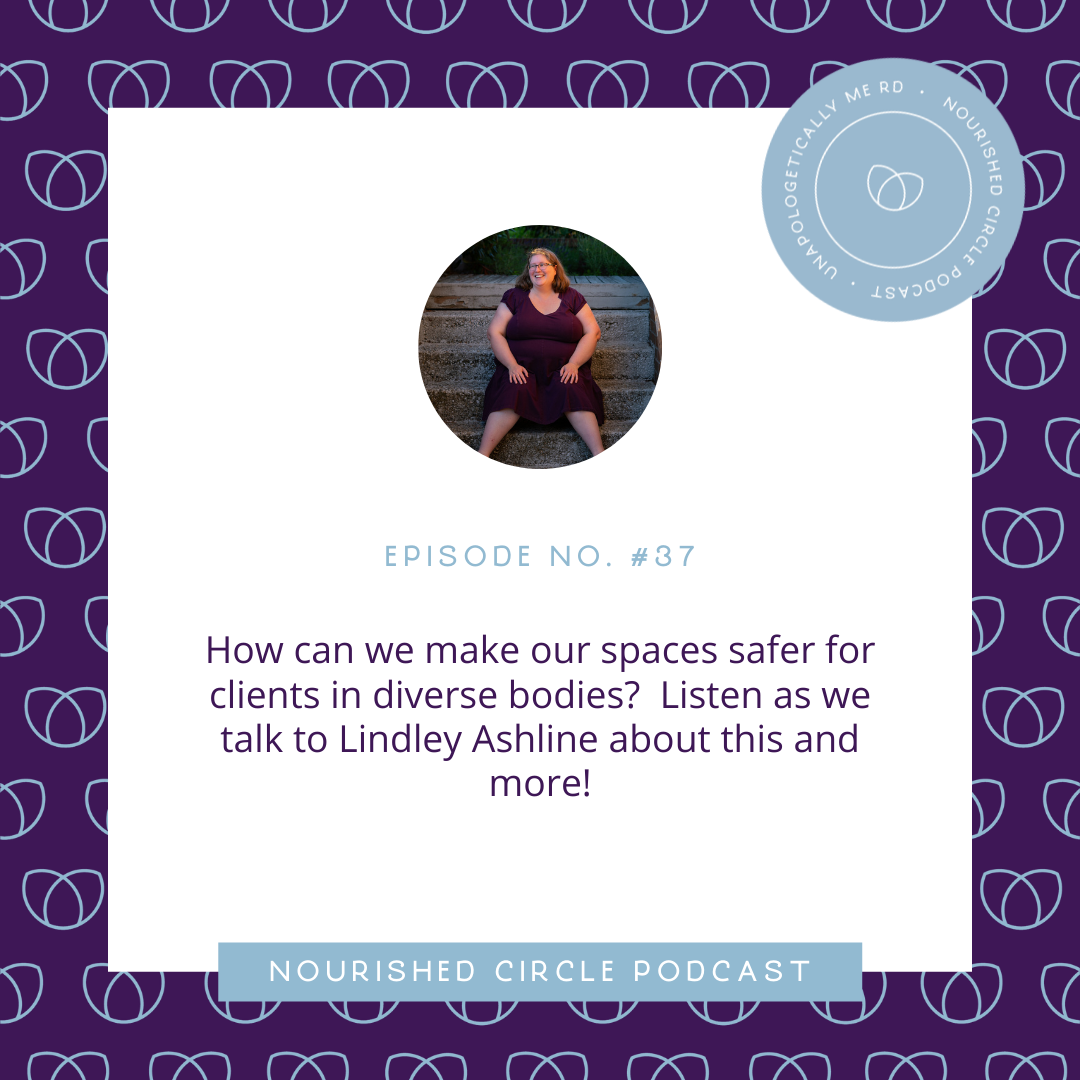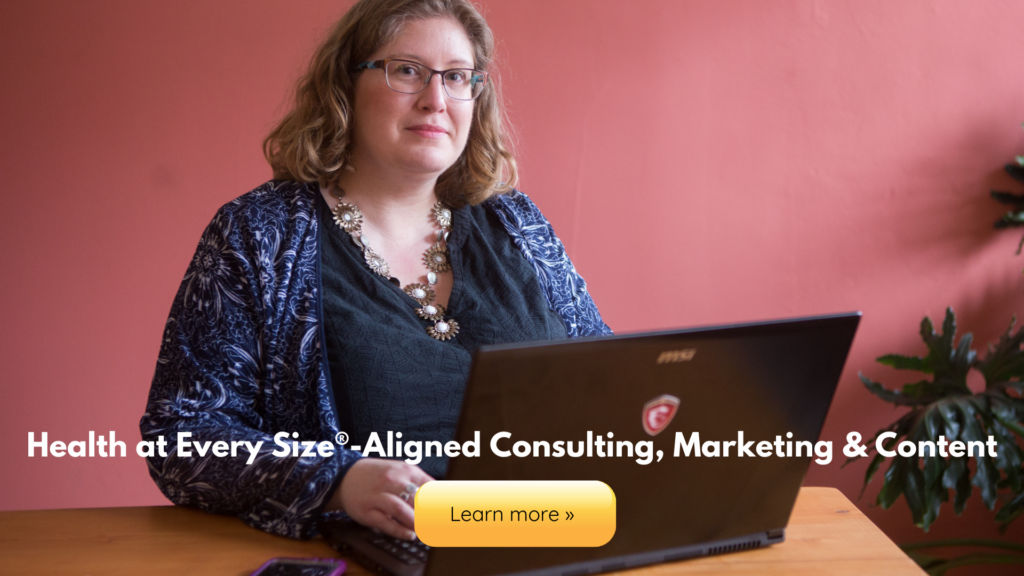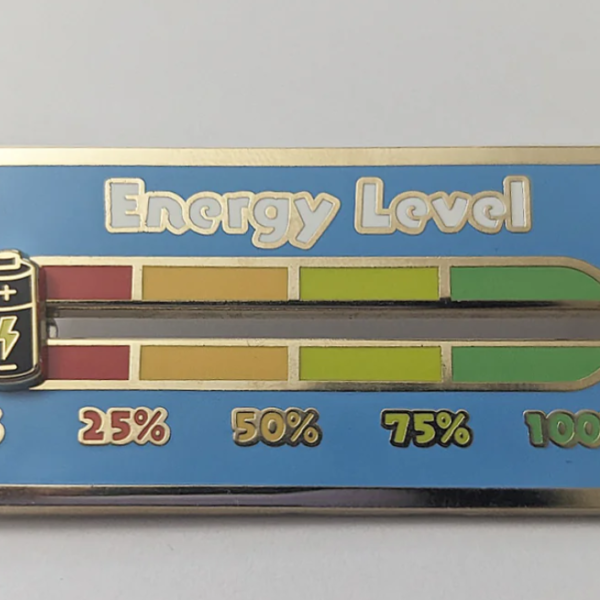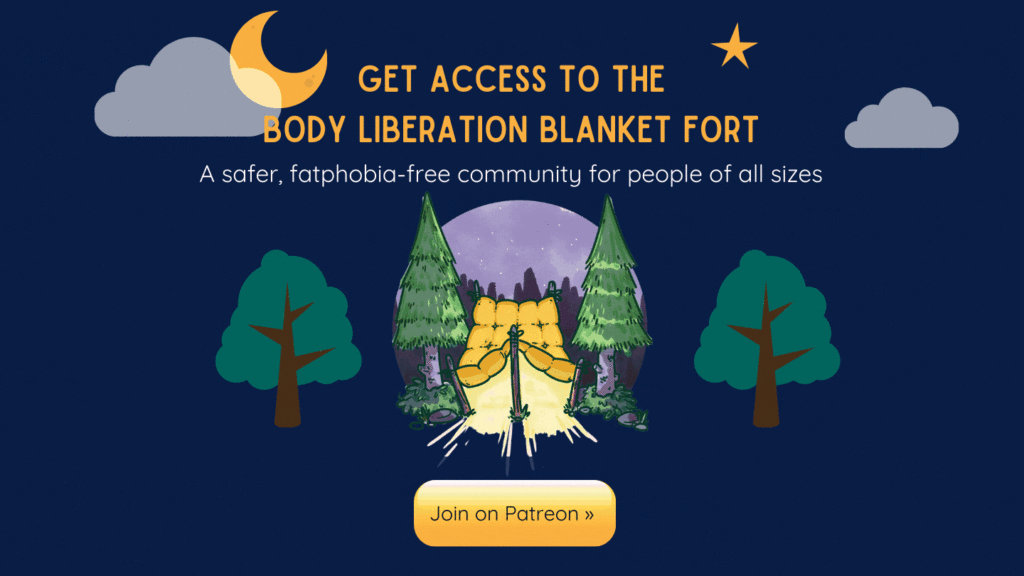{Listen} Lindley on the Nourished Circle Podcast: Weight stigma in healthcare and what providers can change today
I love talking about ending weight stigma in the real world, and how we get there on a practical level. What does that look like? Where do we go from here?
In this episode of the Nourished Circle podcast, I talked with Lori Short-Zamudio about:
- Where weight stigma in healthcare comes from
- How what you were taught in school about bodies and weight may not reflect reality or current science
- The non-glamorous work of making real changes in your practice to better welcome people in large bodies
- Practical, easy and effective changes healthcare providers can make right now
This is a must-listen for clinicians who work with individuals with body diversity — and that’s everyone.
Episode Transcript
Intro: Hello, and welcome back to the Nourished Circle Podcast. I am Lori Short-Zamudio, registered dietician and host of this show. I am so excited to share this conversation with you today. I spoke to Lindley Ashline who creates photographs that celebrate the unique beauty of bodies that fell outside conventional beauty standards. She fights weight stigma by getting fat people a safe place to explore how their bodies look on camera and by increasing the representation of fat bodies in photography, advertising, fine art and the world at large. Lindley is also the creator of Body Liberation Stock, and the Body Love Shop. Find Lindley’s work and get her free weekly body liberation guide at her website which we are going to post in the show notes.
This was an awesome conversation. I have to say that at times we got a little like, ah, because we were talking a lot about how clinicians can make their spaces safer and more welcoming for larger bodies and the work that we need to do as clinicians in order to do that. I absolutely love Lindley’s work and I really loved this conversation. In fact, in my brain, I was like, “Is there a way I can do a part two so I get to talk to Lindley again?” So maybe that will come up in the future, one can only hope. But I really hope that you are able to take something from this today in order to improve your practice if you’re a dietician or a therapist or a clinician working with larger bodies, because I think there’s so much work that we do need to keep doing and Lindley share some of that with us, so enjoy.
Lori: Hello Lindley, welcome to the Nourished Circle Podcast.
Lindley: Thank you.
Lori: So excited to have you here today, and I was excited to connect with you after following your work for so long. So, thank you so much for coming on.
Lindley: Yeah, it’s a delight to be here.
Lori: Before we get started, I was just wondering if there’s any identities or privileges that you would like to share with our audience?
Lindley: Yeah. I feel like sharing these things is actually really important and I’m so glad that you ask your podcast guests because the identities that we hold affect how we see the world. So, I’m 41 years old. I’m a cisgender white woman who lives in the United States. I do live in a very fat body, and you’ll hear me use the word fat throughout this episode. And when I say the word fat, I’m using it as a neutral descriptor of larger bodies. It’s not an insult. I’m not being self-deprecating. That is a word that I, and many other people have reclaimed. You don’t have to use it for yourself, but I want you to know why I’m using it. Beyond that, I’m a small business person and I also live with anxiety and autism.
Lori: Excellent. Thank you so much for sharing all that. I really appreciate your explanation of using the word fat, because I do think that many people get a little taken aback when they hear someone say, “Oh, I’m fat” and not realizing that so many people within the community are reclaiming that word. So, thank you so much for sharing that. What I wanted to talk about today was just kind of that, that how can I as a clinician, I’m a registered dietician, work with individuals in larger bodies and how can we get conversations started? How can we be safer? Because I think that’s one of the concerns that I’m seeing in healthcare is that we’re not taking care of larger body clients as we should be.

Every Monday, I send out my Body Liberation Guide, a thoughtful email jam-packed with resources on body liberation, weight stigma, body image and more. And it’s free. Let’s change the world together. Subscribe »
Lindley: Yeah. And this is something that I’m actually doing more and more consulting on these days because people are recognizing that people in larger bodies aren’t able to access healthcare in the way that we should be able to, in a way that is equitable and respectful and dignified. And note that when I’m talking about healthcare specifically, I am coming from a US perspective, which of course is quite a bit different just in the logistical side and the insurance side and so on than the Canadian side. Weight stigma affects how healthcare providers interact with larger body people, with fat people on so many levels. And more and more people are both becoming aware of this and becoming invested in fixing it. But it’s so pervasive; it’s everything from, what are your chairs like in the waiting room, to, do you have a blood pressure cuff that’s going to fit me, to, do you have internalized weight stigma that you are communicating to your patients, to, when you refer people out to other providers, are you referring them to people who are going to treat them badly?
There’s so many layers to this and it’s become such a complicated topic because the way that providers feel internally about fat folks is then expressed in all these physical things. If you are reluctant to go [unclear05:38] and pull out your large blood pressure cuff, so that you can give me an accurate blood pressure reading. I can sense that even if you think you’re hiding it, and that mindset around fat people, I’m going to be really blunt.
Somewhere around there have been studies and somewhere around 20% of MDs don’t want to touch fat people. I have personally had a doctor who would not touch me. And in that study, that was just the people who would admit to it. Somewhere around 50% of MDs, think that fat patients are automatically non-compliant. The statistics are really horrifying because of course, not only is the weight stigma of society at large, of the developed world expressed throughout our culture, but then we also have when you add the healthcare aspect onto it. Not only is it more severe, but it’s life and death. There are so many stories of people who have died from cancer because they had unexplained weight loss and were congratulated for it instead of that being investigated.
And so, big picture wise, healthcare as a whole has to get past the weight stigma in order to create systemic change. Again, to be really blunt, you have to get over being disgusted by fat bodies. You have to get over not wanting to touch fat bodies. You have to get overthinking that we’re gross and non-compliant and slob and gluttons, and that things like… I don’t generally use the word obese or obesity because they are terms that medicalize perfectly normal variants of human bodies. But you have to get over considering obese people to be like the opposite of anorexia, which is nonsense. Fat people get eating disorders too, and restrictive eating disorders as well. But you got to get over hating fat people; plain and simple. And so, from a big picture standpoint and a long term standpoint, you’ve got to do the internal work, and that’s hard.
That’s hard because we have hundreds of years of stigma and fat phobia and fat hatred, [fatmusia08:26], if you want to use the academic term. We have hundreds of years of reinforcement. And so, working that out, that’s a lifelong thing that if you’re not working on, now is a good time to start. And that sort of mindset adjustment – I do recommend that you work with a health at every size aligned therapist for that. Please don’t ask random fat people on Instagram to guide you through that work for free. You can’t see this as you listen to this episode, but we have our video on right now and Lori just face bombed.
Lori: I did, because it happens and it drives me crazy.
Lindley: Yeah. And the thing is too, again, this is such a big topic that I want to address all of it at once. But first, I want to talk about some really concrete things that you can do. No matter how you feel about fat people to make whatever healthcare you’re providing more accessible to fat people. But first, the first objection that I always get is, well, being fat is unhealthy. And if this is say a troll on Instagram, they just say that. If it’s a clinician, they say it in academic language, but it means the same thing. And from a scientific standpoint, I do want to note that I am neither an academic nor a researcher, but I have yet to have anyone be able to show me a peer reviewed study in which a significant number of participants loss more than 10% of their body weight and kept it off for more than five years.
Lori: I haven’t seen one.
Lindley: We don’t have a reliable way to make fat people less fat or to make fat people thin, so we need to deal with the bodies that we’re dealing with right now. And if you think that a fat person should become thinner, cool, prove it. In my layperson language, “Cool, bro. Prove it.” And until then, we deserve… I mean, even if we did have a way to make fat people thin, fat people would still deserve healthcare. But I do highly recommend reading the book Body Respect by Linda Bacon. Linda now goes by Lindo, just to be clear, but when they wrote the book, they wrote it under Linda bacon and Lucy Aphramor. The book goes into all the science that you can ever want about why intentional weight loss doesn’t work. And again, that’s not necessarily my lane, so I don’t want to delve too far into that today. I really want to focus on some more practical things that we can do.
Lori: That was my entry point, was that book. I recommend it to many as well, as start here, and then we’ll go. That was amazing as an introduction of all the stuff that we need to, because sometimes I sit here as me in my little tiny office going, okay, what can I do to change this massive systemic problem? Only realizing that I can make changes within my office. So if other dieticians or healthcare providers, therapists are listening, what are some things that you would recommend them to start this process of becoming more weight inclusive and less fat phobic? If you could fix the fat phobia in the world, that would be great, because it all stems from there, I think.
Lindley: Yeah. And I think what we’re talking about books and about resources, it’s really important. You know, you just said, oh, it stems from there, and so these things have come together really neatly to talk about this for a moment. So, this is something that was new to me a couple of years ago, and this is something that I’m really learning about now. But what’s actually happened is that fat phobia, the fear in hatred of fat bodies has stems from racism. And again, this is relatively new to me. I had no idea. There is an absolutely phenomenal work that was released a couple of years ago called Fearing the Black Body by Dr. Sabrina Strings. If you’re going to read anything in the next year, Body Respect and Fearing the Black Body are really, and not just personal reading, this is vital professional reading.
Fearing the Black Body traces back four of 500 years of racism and demonstrates how fat phobia was created as part of racism. So as a white woman, I’m essentially collateral damage. And that doesn’t mean that I don’t experience fat phobia. I have some stories, both medical and non-medical, but it means that people who are in brown and black bodies get the worst of it. So, I always try to note that when I’m speaking about this, because yes, it affects me in other white people, but it affects black folks more because it was created specifically as part of a system of oppression aimed at them. So, that is really important to note, that’s where it’s coming from. And so, when you get feedback from people in black and brown bodies, it’s even more important to take that into account. So that said, let’s talk about practical things.
So there’s your mindset, there’s your challenge in your belief system around fat bodies. But let’s talk about your physical spaces. I’ve once had a dermatologist that I went to for a few years where I literally could not sit down in his waiting room. I had to stand in this little bitty waiting room, and like lean back over the chairs when someone else would come in so that they could get through.
Lori: Oh my goodness.
Lindley: Absolutely humiliating. And at the time, I was not as strong of an advocate for myself as I am now. And I didn’t know how to say your waiting room chairs are all tiny and they have arms, I can’t sit in them. What are you going to do to fix it? If nothing else, can I wait in an exam room or something? But seriously, can people sit down in your waiting room? Do you have at least a couple of armless chairs? Some of it is really that simple. Do you have a large blood pressure cuff? Do you have exam rooms with tables for the people who… clinicians who have exam rooms. Are the tables sturdy enough so that they can fit on them? If you’re a massage therapist, is your table wide enough to accommodate larger bodies? These are things that when you move through a space and you’re in a smaller body, you literally don’t notice them because those aren’t obstacles for you. But take a walk through your space and just pretend that whatever body you live in, and of course, not everyone who is listening to this is going to have a smaller body. But whatever body you live in, assume that it’s three times as large. And if you need to hold your hands out from your sides to make that happen, or whatever thing you need to make that visible to you.
Move through your space, see if you can squeeze between the exam table and the wall. See if you can get between the door and that potted plant. Whatever, whatever, just move through your space. And then also, you have done that, see what you can fix. I understand that not everyone is in a building where they control everything. It’s entirely possible that you’re a part of a practice where you can’t just wave a magic wand and change everything in the waiting room, or wave a magic wand and buy new tables, but this is your point to start advocating.
A lot of this is work. A lot of it is not glamorous. It’s advocating for as long as necessary to get an armless chair into your waiting room. It’s sucking it up and investing in what you need, whatever kind of equipment you need to serve all kinds of bodies; not just the ones that are socially acceptable. And I often hear clinicians give feedback or give pushback in the sense that it feels like an expensive extra. It’s like, oh, I have invested all this money into my business and now I got to do more. And the thing is that, once again, this is a mindset thing, because at least in the US, I don’t have Canadian stats on me, but in the US, people who are “overweight or obese”, are something like two thirds of the population.
Not only is our larger people, the majority of the population; we’re not like this weird little niche population that has extra special needs that it would just be ridiculous to consider fulfilling – we’re the majority. And the fact that businesses aren’t already built to accommodate larger bodies is evidence of fat phobia, whether you intended to or not, it doesn’t make you a bad person. It’s just something that you didn’t know and now you do. But it’s also a market opportunity. This is a business opportunity for you to be the one that welcomes people in larger bodies. So, this sort of pushback that I occasionally get that people think that having to do something extra, it’s really not. And even if it were, again, if I can’t sit in the dermatologist waiting room, then I’m going to go to the dermatologist I see now who has a variety of chairs in their waiting room. I don’t have to stand. I can sit on this nice padded bench. I could sit in that chair over there without arms, or I could sit in one with arms.
Lori: Yeah, it seems so simple to me that when you have a business where people are coming to you that you want to be welcoming to everybody that comes in because they’re your clients, they’re your business. Like, I would want to sit before. Standing and waiting for, I don’t know, your doctors. Ours are never on time, so sometimes standing for 25 minutes to 30 minutes, it’s not comfortable. And regardless of the size of your body, like some people can’t stand. Like, that’s disgusting. And the blood pressure cuff thing always blows my mind. I have seen this with my mother who lives in a larger body and always being like, you have super high blood pressure, you have super high blood pressure. And finally, I just said to her, what size cuff do they use? And they were using a too small cuff, and all of a sudden it’s like, oh, your blood pressure is not high. It’s just mind blowing to me that years and years and years of not even thinking to switch the cuff. Don’t we teach that in school? Shouldn’t we teach that in school?
Lindley: Honestly, I don’t know.
Lori: I don’t know either.
Lindley: I’m not a clinician. I have no idea what you all are getting taught.
Lori: No, I’m just thinking like, I didn’t do nursing. I’m just like, now I feel like I need to ask somebody – just what do you learn about that? Because I know as a dietician, I was taught to shrink bodies. That’s the education I got and that never sat well, but I think I know that a lot of internalized fat phobia gets reinforced going through these professions. And then you go out and you’re like, oh, but I can fix that, or whatever terminology they’re using, when people don’t need to be fixed.
Lindley: Yeah. And that’s part of treating fat people with dignity and respect. If I walk in and I’m in a fat body, not only, am I probably there about something. I have probably come to see you for a reason, but I’m not an opportunity for you to save me. There is an increasing strain of thought or I don’t know, maybe a meme in like the old fashioned sense of a cultural strain of thought that says that it’s not fat people’s fault that they’re fat, it’s because they’re sick and we need to cure them of their obesity. And you see this, and I get real salty about this, because you see this in things like these obesity action councils. And I know the Canada one has been particularly showing their tail in the last couple years.
And you see it in things like people with obesity. I live with anxiety. Anxiety is a disorder. There is a problem with my brain that I treat in various ways. I don’t live with obesity. My body is fat. Every woman in my family is fat. We are German peasants, and for hundreds of years, we’ve been fat because it has kept us alive. The fact that I’m sitting here in my fat body is because I’m a survivor. I don’t need to be saved from my human body, so just treat me for whatever I’m there for. An intentional weight loss, even if it might temporarily fix whatever I’m there for, because I can hear people, I can hear people saying, “But what about diabetes?”
New in the Body Love Shop
And not only does intentional weight loss not necessarily “fix or cure” diabetes; since we don’t have a way to meet people thin in the long term, you just end up making people weight cycle. That’s not saving me, that’s going to give me more health problems. We now know that weight cycling and weight stigma are what’s really actually dangerous – not just being a fat person. So, stop trying to fix people. Like, there’s just this increasing sense of pity of, you’re ill, you’re sick, your body is evidence of disease. I’m getting really ranty here, but it’s so toxic. And it has this veneer of, but we love fat people, we just want to help them. And again, we’re not stupid we can tell that not only are you, you as an industry, again, I’m not attacking you the listener personally, but you as an industry are profiting off of erasing us and killing us.
Weight loss surgery, not only is weight loss surgery fails more than half the time in the sense that people regain that weight. Because again, we don’t have a way to make fat people thin, but also, have you seen how dangerous it is? People die all the time. They end up malnourished; that’s what makes them sick, not the fact that they were fat in the first place. Just stop condescending to us. We know the world hates us. We know the world wants us to go away. Here in the States, we have a whole war on obesity. Like, that’s my body you’re warring with. My body is okay. You’re not okay. And thanks for coming to my TedTalk
Lori: I loved it. Loved every second of it. It’s so true because like even the term war on obesity is so violent. There’s nothing supportive, there’s nothing. It’s just, we have a war against you physically. It always blows my mind when I see that. So knowing that many clinicians are taught in very weight stigmatizing ways, and I know you already mentioned some really great books. What can an individual who is wanting to move further into this, what kind of steps can they take? What further education, or even, I guess, what are some language they can use with clients?
Lindley: Oh, I love all these questions. I want to talk all day about every single one of them, but I think there’s what you can start doing personally, and then there’s what you can start changing in your business, because there’s more that you can do than just making sure there’s normal chair in your waiting room. So, let’s talk about the personal. Again, we talked about sort starting to dig into that weight bias, especially the parts that were reinforced for you, from your training, whatever training that you’ve had as a clinician or a provider. Those trainings were almost certainly steeped in fat phobia and racism; because again, we cannot ignore the racist component of this. To start being aware of where those fish hooks lie and pulling them out of your skin as you find them, sorry, that’s a disgusting analogy, but it’s true.
Starting to pull those things out, and again, that may require working with a therapist. It may require hiring someone like me for some consulting time where you can just ask all the things, but what about this, but what about this? Or getting some consulting time with a health at every size educated person in your specific clinical field who can talk to you about these things. So, there’s that personal part of it. And then a piece of advice that often gets given to people who have eating disorders, but also just to anybody who wants to start treating fat people better in addition to improving their own body image. Look at pictures of fat people, watch videos where fat people are speaking about things, follow them on Instagram, follow them on Facebook.
I know that your time is extremely limited and this is important and this is worth it. Most of us, even though we are all very, very busy, still spend some time like on the toilet scrolling Instagram or whatever. Find fat people to follow, find fat liberation activists to follow. I’ve got an article on my website with like 40 some significantly fat people for you to follow because normalizing bodies of all sizes in your mind and not just the ones that get represented, and I’ll come back to representation in a second too. But normalizing larger bodies in your mind helps keep you from viewing them as grotesque or abhorrent or shameful. And it is absolutely vital that you treat fat people, the real ones who are coming to you as patients; it’s absolutely vital that you treat them with dignity and respect like you would anybody else.
Because, part of the reason that we see fat people as unhealthy people is because we don’t go to the doctor, we don’t seek help because we’re treated so badly. There have been medical issues that I personally have put off for years and years actually having them treated, because I didn’t think that I would be able to access treatment that consisted of more than just, “Well, lose weight at fatty.” So, normalizing those bodies is very important. But then on the business side; start putting your words where… make the changes with words. There are a couple of different ways you can do this. One like Lori was talking about is… Sorry, there’s somebody’s car alarm is going off outside my window and I’m hoping it’s not on the video, on the recording.
Lori: I thought it was my window, so I just muted my microphone. I was like, is that me?
Lindley: No, it’s me. It’s me. Earlier today it was a leaf blower, you never know. At any rate, the point is that, Lori was asking like, what words to use with your clients. And this is a fascinating question, and I guarantee you that in 10 years, my answer will be different. Here in 2021, even a lot of fat folks don’t want to be called fat, because culturally, it is still an insult. People are getting banned on Facebook for using the word fat because it’s an insult. And also as a fat person, if I see a clinician who is in a thin or thinner body using the word fat, unless they have been very clear about their opinions, I don’t necessarily know how they’re using it. So a lot of clinicians are hesitant to use the word fat and I think that’s appropriate, I think that hesitation is appropriate. But a major change that you can do right now is to scrub all of your material, your website, your marketing, your office of the words, obese and obesity. If you need a term, you can say people in larger bodies, people in higher weight bodies. There are several terms you can use that are respectful, that aren’t as polarizing as the word fat, but that also don’t unnecessarily medicalize us. So, I usually just advise using people in larger bodies. It’s clear, it’s accurate and it’s pretty neutral.
Lori: I was thinking that it’s something thing that I get a lot of pushback from. “Oh, but it’s a term, it’s a diagnosis. We’re supposed to use that in healthcare.” And I always say, no, I don’t like the word. I don’t think people I work with like that word, but it it’s something that I’m just wondering, how can we really get away from it when it’s now a diagnosis – according to whoever makes diagnosis of things?
Lindley: Yeah, at least here in the US, it’s in the billing codes and things for insurance. You know, it’s a combination of being the change you want to see and also pushing back in your professional life. So many people are in professional organizations around their areas of healthcare specialties, push back, be the person who advocates. And the thing is that, yes, I understand that’s professionally risky. If you go into whatever dietician professional society or organization that you’re a member of, and you’re the person who gets on the education committee and you start pushing back about obesity; it is professionally risky. But I’m assuming that if there were a different marginalized population that your organization wanted to talk about eliminating and condescending to and patronizing, that you would push back because it would be the right thing to do.
Fat phobia, you can’t compare oppressions. Fat phobia is not the same as racism and it’s not the same as ableism; each one is different and they layer on top of each other. But it is your responsibility as a professional to do the least harm, and to do the least harm, that requires speaking out. And I mean, let me tell you, as a fat photographer, I don’t have very many photographer friends. I don’t have people who refer people to me as clients. I don’t have a professional network and it is because I’m the fat photographer who photographs fat people and talks about fat all the time. There have been professional consequences for me, but I can’t escape those because I’m fat, so the least you can do is speak up in a committee meeting. And the more people that do that, that’s how we change the world.
These obesity action councils, they exist because they make money. Stop making it profitable. Stop referring people for weight loss surgery. Stop giving people Metformin to try to make them thin. Stop diagnosing pre-diabetes just because people are fat. Stop making it profitable. And that is, you have the power here. And I know that as an individual, you’re like, I’m a really busy person, I’m one person; stop making it profitable. Stop sharing those materials. Stop supporting them. Because you and I, as individuals, we can’t change what Merck is doing. We can’t change what Novo Nordis is doing. We can’t change that. But the less we support it, the better, because that is what changes it. If half of the industry says, ‘Oh, no, no. Why would you treat fat people like that? That’s awful. That’s stigmatizing and medicalizing and it kills people.” That’s going to be a lot less profitable.
Lori: Yeah. It’s so unfortunate, and it always comes back to money though.
Lindley: It really does. I mean, well, I’ve already talked about… you can rewind and listen to what I said about medicalizing terms and how I don’t live with obesity. I mean, increasingly it is being considered to be a diagnosis, but my body is not inherently ill because it is fat. We have always had fat people, in the same way that you wouldn’t automatically medicalize someone who’s very thin or someone who has a particular birthmark. Like the big Weinstein birthmarks, like that’s not an illness.
Lori: Yeah, so true.
Lindley: Yeah, at any rate, you can rewind and listen to that again. But yeah, my body’s not an illness.
Lori: Yeah, and I think as clinicians, I agree, we need to start advocating more. And I realize you said this a few minutes ago, but I a hundred percent love the list you have for people to follow on Instagram on your website. I went back through it and found like, I think for I people that I hadn’t already followed and I was like more and more and more, and it’s something that I do with a lot of clients as well, just to start to normalize body diversity for them. And it’s something I do with my students. I teach at college course as well, because you have to start seeing that and the rest of social media… I don’t know what the word is. I’m looking for. Filtered, filtered might be a good word.
So I would encourage people to go find that list and start following, follow, follow, follow, follow, follow. And you also start to learn great…
Lindley: We can put it in the show notes too.
Lori: Yeah. You also start to learn some things, right. When you start to follow other advocates and you follow people whose lived experiences they talk about. And I think I’m just thinking back to what we can do as clinicians is to honor the client’s lived experience too, right? When you say something is bothering you or something hurts, or I tell this to all dieticians, we need to believe people when they say what they eat. You can’t look at a person’s body and know what they eat, ever.
Lindley: I love broccoli. I love broccoli. I also love Cheetos, just like you, you know.
Lori: I don’t like broccoli. I always joke I’m going to be fired from dietician world because I hate broccoli.
Lindley: Like roasted broccoli with some [unclear38:38], olive oil, tons of garlic, amazing!
Lori: That I might like.
Lindley: Yeah. I mean raw broccoli’s fine, but we do roasted broccoli a lot.
Lori: I’m going to try that.
Lindley: This is now a recipe podcast?
Lori: Exactly, whatever direction we go, we go.
Lindley: Yeah, we have studies out there that show that thin people eat approximately what fat people eat. I’m just like you, I’m a normal human being too. Sometimes I eat ice cream and sometimes I don’t. But yeah, talking about this normalizing bodies and representation, this is why a photographer is here talking to you about weight stigma. Because what I do is stock photography, I also do client photography, I do activism, I’m a writer, I do consulting, but the core, the heart of what I do is stock photography of fat people. And it’s one of the ways… it’s so cool because it just changes the world in every direction. There are people who will use my website as also a way to learn to see fat bodies as normal, because there are thousands of photographs of primarily fat people on the site and people will just go through and look at them. For people who are in bodies like that, sometimes it’s the first time they’ve ever seen a body like theirs photograph respectfully, ever.
Lori: Wow.
Lindley: And so, it changes the world for the people who aren’t looking at them. It changes lives through the people who are in those photos, because what kind of power does it give you for somebody to come to you and say I want your body to represent like yours in a world where there is very little representation. Like, what kind of power does that give the people in those photos? But then for the people who buy the photos and use them in their marketing and on their website and on their social media, it changes the world directly there too, because it is directly normalizing bodies. It is directly changing the representation. And also on top of that, I get so excited when I talk about this. On top of that, again, this is a market opportunity, and there are many, many people with bodies like mine. I am not a particularly outlying outlier on the spectrum of human bodies. If I go to your website, to your RD website or to your massage therapy website or your practices website and I see a variety of bodies and not just like smiling white, thin woman laughing alone with salad. Like, if I see bodies like mine, that’s the practice I’m going to go to because I know that not only are you more likely to give me treatment, but that you were committed enough to it to represent me. That’s amazing.
New at Body Liberation Stock
That changes the world for the people who see your website. That brings you business, honestly. Because if you’ve got a fat person on your website, I can assume you’re at least more likely to have a blood pressure cuff that will fit me or a chair I can sit in. So again, you kind of have to match this with action, you know?
Lori: Yeah, totally.
Lindley: Because again, if I come to your practice because you put a fat person on your website and then you treat me poorly, well, I’m not going to come back. And then word gets around too, so then other fat people will hear about that. But it’s such an easy way to change the world and in so many directions, and it’s such vitalizing work to do and I’m so proud of it because right now, I’m the only one in the world doing it.
Lori: Yeah, when I redid my website two years ago, all my stock photos are from you, which I just have to say, I have a whole second set for when I decide to redo it again because I couldn’t decide because there’s so many beautiful ones. But when I was working with someone and they’re like, well, can you give me a couple names of places you want me to go to photos? I was like, no, there’s only one, and this is where you’re going to go, and this is what I want. And she was like, there’s only one. I’m like, there’s only one. And it was just interesting to me because also they’ve done websites before and no one had really necessarily asked for that type of photo. But I will tell you, I have gotten so much positive feedback from just the photos on the website. And people asked me, where did you get those, and things like that. And to me, it wasn’t a big thought process to do. It was like I wanted inclusive bodies everywhere. But it was surprising when I was like, oh no, there’s only one. There’s one place to go, that’s the only spot we’re going.
Lindley: And it’s just startling how few resources there are out there for this. Last year I was diagnosed… actually early this year, I guess I was diagnosed with sleep apnea. It was sudden onset after some dental work. And if you want to talk about a fat phobic process, Ooh, at any rate. At any rate, I now use the CPAP machine and I named it Whistler, because if you’ve ever been around one, if the seal gets loose, it makes this really loud whistling sound. Point being, when that started, being on my radar, I went and looked to see what kind of photos I could find around CPAPs. And sleep apnea is so associated with larger bodies, whether that is scientifically reasonable or not, it is so associated with larger bodies that I assume that there would be some photos out there. And there just really aren’t. Like respectful photos of fat people using CPAP machines. And so, my husband photographed me, and so now there’s a whole set and I’ll be releasing those soon. By the time you listen to this, they may be up on the website. But like, how did this not exist?
Lori: No, that’s in nuts to me. Yeah, so much to change. This is only just a tiny little piece of the things. But I also want to be very mindful of your time and I could talk about this for hours, I’m not going to lie. Like, this could be a month long series, I think. I like to finish up with a question of what is nourishing you right now.
Lindley: Ooh, that’s a good question. Here in Seattle, we’re heading into fall, into sort of mid-fall, which means that the gloom has arrived and the gloom will not go away until next July 4th.
Lori: Really?
Lindley: I know that Lori lives significantly further north than I do and is probably rolling her eyes right now about how much I hate Seattle winters. But last year I picked up the pandemic hobby of growing house plants, and I have, I don’t know, somewhere north of 80, at least at this point.
Lori: Oh wow.
Lindley: And because I discovered that having green things, green growing things in the house and having the full spectrum lights to make them grow during our long winters here was really nourishing to me as well. And so, it’s helped significantly during the winter. So, I’m spending a lot of time with my plants right now and gearing up for that long winter season with all my different plants. And it feels so cozy and wonderful, and yeah, it’s really nourishing right now.
Lori: Oh, that’s cool. I have no plants at my house because I kill them all. So maybe you could shoot me a rec sometime of what I won’t. I killed succulents. I can kill anything.
Lindley: I’m not very good with succulents.
Lori: They’re not as easy as the internet makes me think they are.
Lindley: They’re not.
Lori: So if people are interested in finding you, following you, where can they find you all on the interwebs?
Lindley: You can find all my work, including stock photos and consulting and the blog and everything else at bodyliberationphotos.com. I do send out three free stock photos every month in my newsletter, the Body Liberation Guide, that is on the website under more, or you can get to it by going directly bit,ly/bodyliberationguide. And I have a pretty active Instagram that has lots of advocacy posts and videos, and it is at Body Liberation with Lindley.
Lori: Awesome. Thank you. And yes, you do have amazing advocacy posts that make me think and I appreciate that. I like social media that me makes me think. Lindley, it has been awesome having you on today. I want to thank you so much for taking time out of your Seattle fall to spend time with us and talk about this extremely important topic. So, thank you so much for coming today.
Outro: Thank you for listening to today’s episode of the Nourished Circle. Don’t forget to like on iTunes or Spotify and subscribe so that you never miss an episode.

Every Monday, I send out my Body Liberation Guide, a thoughtful email jam-packed with resources on body liberation, weight stigma, body image and more. And it’s free. Let’s change the world together. Subscribe »
Hi there! I'm Lindley. I create artwork that celebrates the unique beauty of bodies that fall outside conventional "beauty" standards at Body Liberation Photography. I'm also the creator of Body Liberation Stock and the Body Love Shop, a curated central resource for body-friendly artwork and products. Find all my work here at bodyliberationphotos.com.









![Illustrated Art Stock: Plus Size Woman Covered with Flowers [Body Liberation Stock exclusive] - Body Liberation Photos & Stock](https://bodyliberationphotos.com/wp-content/uploads/2024/09/Illustrated-Art-Stock-Plus-Size-Woman-Covered-with-Flowers-Body-Liberation-Stock-exclusive-94337-600x600.jpg)
![Illustrated Art Stock: Plus Size Woman Twirls in a Skirt [Body Liberation Stock exclusive] - Body Liberation Photos & Stock](https://bodyliberationphotos.com/wp-content/uploads/2024/09/Illustrated-Art-Stock-Plus-Size-Woman-Twirls-in-a-Skirt-Body-Liberation-Stock-exclusive-94328-600x600.jpg)
![Illustrated Art Stock: Plus Size Woman Twirls in a Skirt [Body Liberation Stock exclusive] - Body Liberation Photos & Stock](https://bodyliberationphotos.com/wp-content/uploads/2024/09/Illustrated-Art-Stock-Plus-Size-Woman-Twirls-in-a-Skirt-Body-Liberation-Stock-exclusive-94323-600x600.jpg)
![Illustrated Art Stock: Plus Size Woman with Hands Over Breasts [Body Liberation Stock exclusive] - Body Liberation Photos & Stock](https://bodyliberationphotos.com/wp-content/uploads/2024/09/Illustrated-Art-Stock-Plus-Size-Woman-with-Hands-Over-Breasts-Body-Liberation-Stock-exclusive-94318-600x600.jpg)
![Illustrated Art Stock: Plus Size Woman with Hands Over Breasts [Body Liberation Stock exclusive] - Body Liberation Photos & Stock](https://bodyliberationphotos.com/wp-content/uploads/2024/09/Illustrated-Art-Stock-Plus-Size-Woman-with-Hands-Over-Breasts-Body-Liberation-Stock-exclusive-94313-600x600.jpg)






